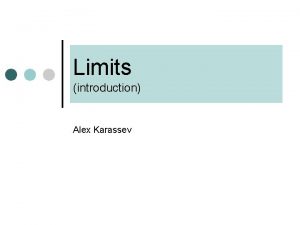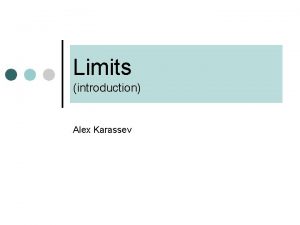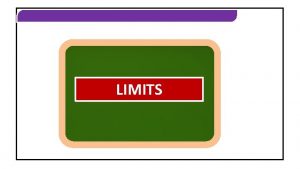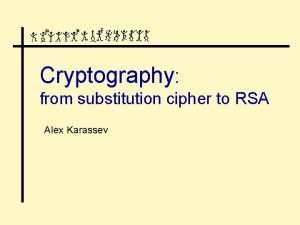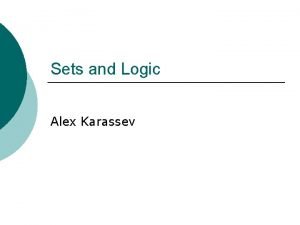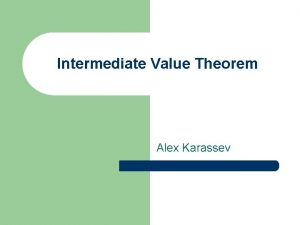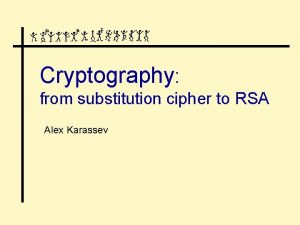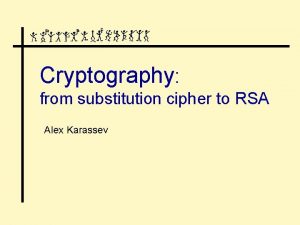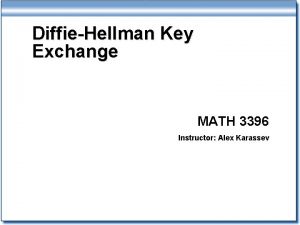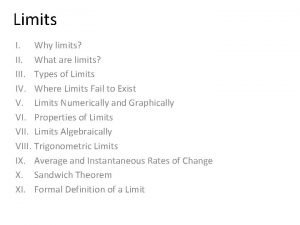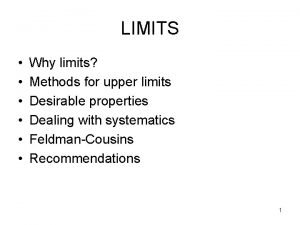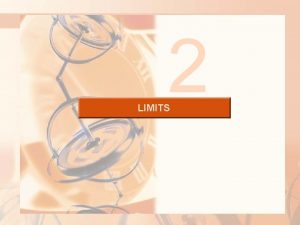Limits introduction Alex Karassev The concept of a




























- Slides: 28

Limits (introduction) Alex Karassev

The concept of a limit What happens to x 2 when x approaches 2? ¢ Look at table of values: ¢ x x 2 1. 999 3. 61 3. 9601 3. 996001 |x 2 - 4| 0. 39 0. 0399 0. 003999 2. 1 2. 001 4. 41 4. 0401 4. 004001 0. 41 0. 0401 0. 004001

Direct substitution Thus we see that x 2 approaches 4, i. e. 22, as x approaches 2 ¢ So we can just substitute 2 in the function x 2 ¢ Is it always the case? ¢

Example: direct substitution is impossible Look at (x 3 -1)/(x-1) as x approaches 1 ¢ We cannot sub. x=1, however, we can substitute the values of x near 1 ¢ x 0. 999 (x 3 -1)/(x-1) 2. 71 2. 9701 2. 997001 x 1. 1 1. 001 (x 3 -1)/(x-1) 3. 31 3. 0301 3. 003001 0. 9999 2. 99970001 1. 0001 3. 00030001 Guess: (x 3 - 1) / (x - 1) approaches 3 as x approaches 1

Measuring the earth… How to decide whether a planet is flat or "round"? ¢ Look at circles of the same radius on a sphere and on the plane and compare their circumferences ¢

Circumferences Sphere of radius R Euclidean plane r Cr Cr r a R θ R Cr = 2π a Cr = 2π r So Cr / r = 2π is constant! (does not depend on circle) a = R sinθ and r=Rθ So Cr / r = (2π a) / r = (2π R sinθ) / (R θ) = 2π (sinθ / θ) Depends on θ and hence on the circle!

What if θ is very small? r When θ is small the piece of sphere enclosed by our circle is "almost flat", so we should expect that Cr Cr / r is very close to 2π θ However, Cr / r = 2π (sinθ / θ) Therefore, when θ is close to 0, sinθ / θ is close to 1 ! θ is close to 0 Guess: sinθ / θ approaches 1 as θ approaches 0 Equivalently: sinθ ≈ θ when θ is near 0

Example: what is sin 1° ? sinθ ≈ θ when θ is near 0 ¢ 1° = π / 180 radians, so θ = π / 180 ¢ We have: sin 1° = sin (π / 180) ≈ π / 180 ≈ 3. 14 / 180 = 0. 0174444… ¢ Calculator gives: sin 1° ≈ 0. 017452406 ¢

Table of values for sinθ / θ θ 0. 5 0. 4 0. 3 sinθ / θ 0. 958851077 0. 973545856 0. 985067356 0. 2 0. 1 0. 001 0. 0001 0. 993346654 0. 998334166 0. 999983333 0. 999999833 0. 99998

Graph of y = sinθ / θ y 1 -π π θ

Danger of guessing ¢ What happens to when x approaches 0? x f(x) 0. 010099828 0. 0011 0. 0002 0. 00001 0. 00011 What is our guess?

Danger of guessing ¢ More values… x f(x) 0. 0011 0. 0002 0. 00001 0. 00011 0. 000001 0. 000101 0. 0000001 0. 0001001 0. 00000001 0. 0001 What is our guess now?

Solution ¢ As x approaches 0: ¢ sinx approaches sin 0 = 0 ¢ cosx approaches cos 0 = 1 ¢ So sinx + cosx / 10000 approaches 0 + 1 / 10000 = 0. 0001 ¢

Informal definition ¢ We write if we can make the values of f(x) as close to L as we like by taking x to be sufficiently close to a but not equal to a ¢ Note: the value of function f at a, i. e. f(a), does not affect the limit!

Examples y 4 y=f(x) x 2 When we compute limit as x approaches 2, x is not equal to 2

Does limit always exist? y y=h(x) 1 0 x ¢ If x approaches 0 from the left then h(x) is constantly 0 ¢ If x approaches 0 from the right then h(x) is constantly 1 ¢ Thus when x is close to 0 h(x) can be arbitrarily close (in fact, even equal to) 0 or 1 and we cannot choose either of this two numbers for the value of the limit of h(x) as x approaches 0 ¢ So does not exists (D. N. E. )

One-sided limits Limit of f(x) as x approaches a from the left ¢ Limit of f(x) as x approaches a from the right ¢

From the left ¢ We write if we can make the values of f(x) as close to L as we like by taking x to be sufficiently close to a and less than a f(a) y y = f(x) L x x a

From the right ¢ We write if we can make the values of f(x) as close to L as we like by taking x to be sufficiently close to a and more than a f(a) y y = f(x) L a x x

Theorem

Infinite limits Let f(x) = 1/x 2 ¢ If x is close 0 then 1/x 2 is a very large positive number ¢ Therefore the finite limit of 1/x 2 as x approaches 0 does not exist ¢ However, we may say that 1/x 2 approaches positive infinity as x approaches 0 ¢ y M 0 x

Infinite limits We write if we can make the values of f(x) bigger than any number M by taking x to be sufficiently close to a and not equal to a (note: think of M as of large positive number) ¢ We write if we can make the values of f(x) smaller than any number M by taking x to be sufficiently close to a and not equal to a (note: think of M as of large negative number) ¢

Infinite limits: one-sided limits y x 0

Vertical asymptote ¢ Definition we say that a line x=a is a vertical asymptote for the function f if at leas one of the following is true:

Example What happens when x approaches 0? x 1/2 1/3 1/4 sin(π/x) sin(π/1/2)=sin(2 π)=0 0 0 1/n sin(π/1/n)=sin(πn)=0

However… x 2/5 2/9 2/13 2/17 2/(4 n+1) sin(π/x) sin(π/2/5)=sin(5/2)π= sin(π/2 + 2 π) = sin(π/2) = 1 1 1

Limit does not exist!

 Horizontal
Horizontal Real limits vs. apparent limits
Real limits vs. apparent limits Hình ảnh bộ gõ cơ thể búng tay
Hình ảnh bộ gõ cơ thể búng tay Bổ thể
Bổ thể Tỉ lệ cơ thể trẻ em
Tỉ lệ cơ thể trẻ em Gấu đi như thế nào
Gấu đi như thế nào Tư thế worms-breton
Tư thế worms-breton Chúa sống lại
Chúa sống lại Các môn thể thao bắt đầu bằng tiếng nhảy
Các môn thể thao bắt đầu bằng tiếng nhảy Thế nào là hệ số cao nhất
Thế nào là hệ số cao nhất Các châu lục và đại dương trên thế giới
Các châu lục và đại dương trên thế giới Công thức tính độ biến thiên đông lượng
Công thức tính độ biến thiên đông lượng Trời xanh đây là của chúng ta thể thơ
Trời xanh đây là của chúng ta thể thơ Mật thư tọa độ 5x5
Mật thư tọa độ 5x5 Phép trừ bù
Phép trừ bù Phản ứng thế ankan
Phản ứng thế ankan Các châu lục và đại dương trên thế giới
Các châu lục và đại dương trên thế giới Thể thơ truyền thống
Thể thơ truyền thống Quá trình desamine hóa có thể tạo ra
Quá trình desamine hóa có thể tạo ra Một số thể thơ truyền thống
Một số thể thơ truyền thống Cái miệng xinh xinh thế chỉ nói điều hay thôi
Cái miệng xinh xinh thế chỉ nói điều hay thôi Vẽ hình chiếu vuông góc của vật thể sau
Vẽ hình chiếu vuông góc của vật thể sau Biện pháp chống mỏi cơ
Biện pháp chống mỏi cơ đặc điểm cơ thể của người tối cổ
đặc điểm cơ thể của người tối cổ Thế nào là giọng cùng tên?
Thế nào là giọng cùng tên? Vẽ hình chiếu đứng bằng cạnh của vật thể
Vẽ hình chiếu đứng bằng cạnh của vật thể Tia chieu sa te
Tia chieu sa te Thẻ vin
Thẻ vin





























